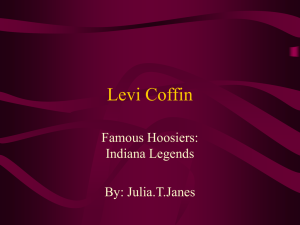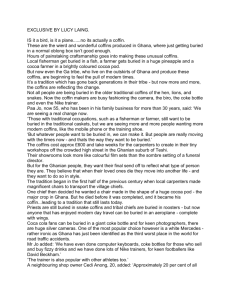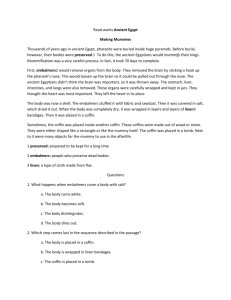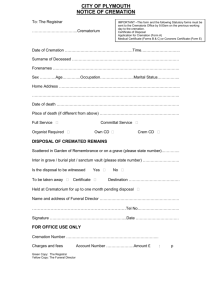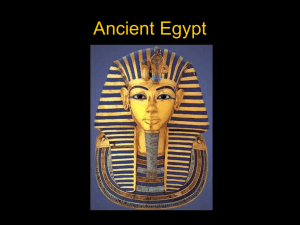Guide to Coffins and Alternatives
advertisement
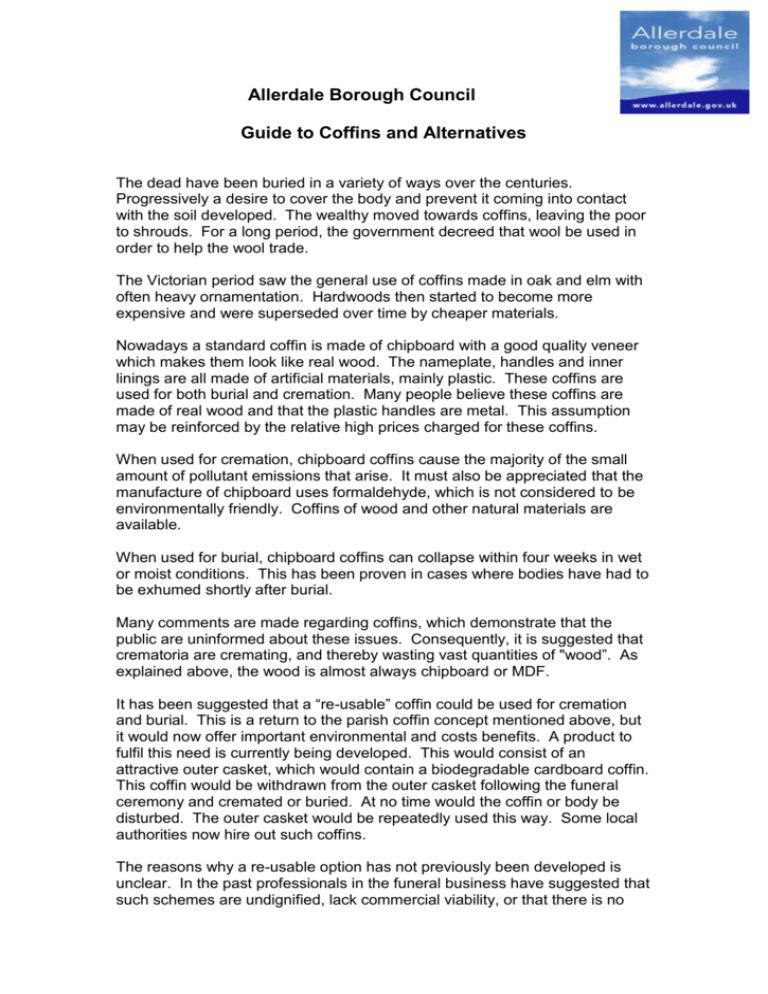
Allerdale Borough Council Guide to Coffins and Alternatives The dead have been buried in a variety of ways over the centuries. Progressively a desire to cover the body and prevent it coming into contact with the soil developed. The wealthy moved towards coffins, leaving the poor to shrouds. For a long period, the government decreed that wool be used in order to help the wool trade. The Victorian period saw the general use of coffins made in oak and elm with often heavy ornamentation. Hardwoods then started to become more expensive and were superseded over time by cheaper materials. Nowadays a standard coffin is made of chipboard with a good quality veneer which makes them look like real wood. The nameplate, handles and inner linings are all made of artificial materials, mainly plastic. These coffins are used for both burial and cremation. Many people believe these coffins are made of real wood and that the plastic handles are metal. This assumption may be reinforced by the relative high prices charged for these coffins. When used for cremation, chipboard coffins cause the majority of the small amount of pollutant emissions that arise. It must also be appreciated that the manufacture of chipboard uses formaldehyde, which is not considered to be environmentally friendly. Coffins of wood and other natural materials are available. When used for burial, chipboard coffins can collapse within four weeks in wet or moist conditions. This has been proven in cases where bodies have had to be exhumed shortly after burial. Many comments are made regarding coffins, which demonstrate that the public are uninformed about these issues. Consequently, it is suggested that crematoria are cremating, and thereby wasting vast quantities of "wood”. As explained above, the wood is almost always chipboard or MDF. It has been suggested that a “re-usable” coffin could be used for cremation and burial. This is a return to the parish coffin concept mentioned above, but it would now offer important environmental and costs benefits. A product to fulfil this need is currently being developed. This would consist of an attractive outer casket, which would contain a biodegradable cardboard coffin. This coffin would be withdrawn from the outer casket following the funeral ceremony and cremated or buried. At no time would the coffin or body be disturbed. The outer casket would be repeatedly used this way. Some local authorities now hire out such coffins. The reasons why a re-usable option has not previously been developed is unclear. In the past professionals in the funeral business have suggested that such schemes are undignified, lack commercial viability, or that there is no “demand”. These comments are rarely substantiated and generally reflect personal opinion. Consequently the bereaved are, in effect, compelled to buy mass produced chipboard coffins. These are very cheap to manufacture and designed to look like craftsman produced items. If funerals were priced differently, it would allow coffins to be purchased by the bereaved from any source, and enable the re-useable options to be introduced. This would offer greater freedom and choice. Why should this be so important? The coffin is probably the most symbolic and central item of the funeral. Unless a choice of coffin or alternative is easily available, the deceased and bereaved are unable to express their needs or philosophy. The choice should allow for a range of containers from the ostentatious through to the simple. The ostentatious could include a coffin crafted in the shape of a car, for a motoring enthusiast, or carved in natural wood by a joiner, to last a few hundred years in the soil. The high cost these items, to which the funeral director adds his charges, makes them very expensive. In contrast, the simple cardboard coffin or shroud can be used as a symbol of the deceased’s concern for the environment, or because they are opposed to the high costs associated with funerals. The coffin, of any type, can be personalised to reflect personal interests e.g. a gardener, fisherman or football fan. The artistic options are individual; require skills and time, all elements that are generally missing with the current funeral arrangements. Other options have developed in recent years. In 1994, three manufacturers of biodegradable (cardboard) coffins arose and some funeral directors, crematoria and cemeteries are offering these products. This move was in response to the environmental burial schemes opening around the country, although these coffins were quickly utilised for traditional burial and cremation. Little research has been done, although findings in Europe suggest that ‘cardboard’ coffins offer a significant reduction in pollutant emissions arising from cremation. In addition, the cardboard coffin may reduce what people may see as a waste of resources, due to cremating standard coffins. The cardboard coffin immediately offered the advantages of wider choice, lower cost and biodegradable benefits when used for burial. The coffins are rigid, carry well and retain any potential leakage of body or embalming fluid that may arise. The cardboard coffin was rapidly labelled ‘cheap’ and lacking in ‘dignity’ by some people. This of course, is a matter of opinion. The word dignity is defined as ‘true worth’ and where a person has a belief in protecting the environment, or having a modest funeral, then a cardboard coffin has true worth to that person and they should be given the choice. An added advantage is that cardboard coffins can be painted attractively or personalised by an artist or the family themselves. Paint can be extremely flammable and some crematoria may restrict this option, because of the flashback when the coffin is charged into the cremator. It is worth noting that water based paint does not pose this problem. Also, where the box shape, or cardboard finish is felt to be upsetting visually, it is a simple matter to cover the coffin with a pall. This is a velvet type cloth, often with a gold braid edge, traditionally used in the past to cover coffins. These are often available from funeral directors or may be provided by crematoria or cemeteries for use at a funeral. Alternatively, home made palls, patchwork quilts or similar could be used, provided they are large enough. Another recently developed ‘green’ option is the burial shroud. This consist of a board, upon which the body is laid, the whole being wrapped in a large piece of woven, soft, wool cloth. The shroud is sold with black, pure cotton ropes, which are attached and used by four or six bearers. The shroud is suitable for all forms of burial, but not cremation. Wood is not normally mandatory and any natural material could be used. If you are arranging a funeral and you are unable to obtain a coffin, your Charter member has a minimum requirement to facilitate the supply of a biodegradable coffin to you, in response to the Charter item on ‘Funerals without a Funeral Director’. If you wish to make your own coffin or container, contact your Charter member for advice over suitable materials, design and dimensions. Other materials that are bio-degradable may be ideal for containing a body. Plaited willow, bamboo or straw are possibilities. As a rule, coffins for burial should be constructed to the smallest size possible, as this reduces the size of the grave excavation and improves safety margins. Smaller and thereby lighter coffins also reduce the weight carried by the bearers, which may prevent physical injury. For cremation, the design, construction and materials used in the coffin must be such that it minimises the use of fossil fuels. It is important to note that the manufacturer of a coffin, whether a commercial concern or a private individual, has a ‘duty of care; to those who will subsequently be involved with it. Obviously, it is necessary to ensure that it is strong enough to hold the body whilst being carried. Less obviously, if varnishes or oil based paints are used, these could cause a flashback when the coffin is placed into a pre-heated cremator. The Federation of British Cremation Authorities (FBCA), which represents cremation authorities in the UK, issues a directive of coffin design. This prohibits the use of materials such as PVC, pitch or zinc, which pollute the atmosphere. It is important to consider the explosion or pollutant impact of anything placed in a coffin, especially for cremation. Heart, pacemakers, implant batteries, pressurised containers, even coconuts, have all caused explosions. The medical implants can be removed by a doctor, a mortician or the funeral director. Even clothes made out of man-made fibres, shoes or any rubberised materials can cause smoke and pollution. As crematoria have to operate within the Environmental Protection Act 1990, these can cause serious operational difficulties. Most metals including jewellery, bolts or screws, artificial joint and bone splints, pass through the cremation cycle without difficulty, and are withdrawn at the finish. Jewellery melts and is unrecognisable, forming small pieces of aggregate. These, and all other metallic residue are buried in the grounds and are not removed off site or sold for re-use. The re-use of metallic joints, splints, etc is considered under the Charter item ‘Environmental issues’. The use of balms, scents, flowers and other natural materials should not pose any difficulties. Check with your Charter member if you are in any doubt. Charter Rights a. It is your right to choose the type and design of coffin, within the constraints of availability, regulations and safe materials. b. It is your right to receive information on obtaining a coffin (biodegradable type) via your Charter member. Charter Rights a. It is your right to choose the type and design of coffin, within the constraints of availability, regulations and safe materials. b. It is your right to obtain a coffin (biodegradable type) via your Charter member. For further information contact: Bereavement Services Office Allerdale Borough Council Allerdale House New Bridge Road Workington CA14 3YJ Tel: 01900 702620 email: bereavement.services@allerdale.gov.uk
